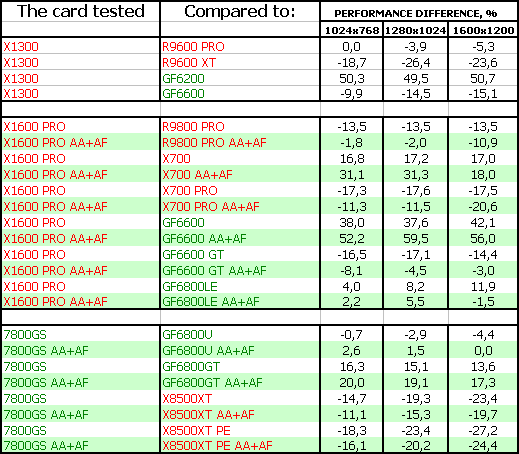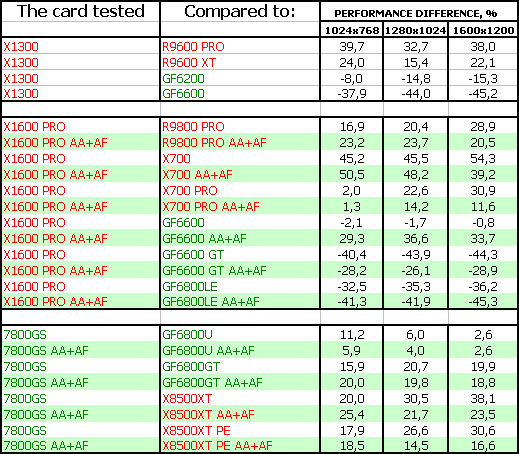Last of the AGP Mohicans:
GeCube RADEON X1300 256MB AGP
Sapphire RADEON X1300 256MB AGP
Sapphire RADEON X1600 PRO 256MB AGP
Leadtek WinFast A7800 GS TDH (GeForce 7800 GS) 256MB AGP
|
TABLE OF CONTENTS
- Introduction
- Video cards' features
- Testbed configuration, benchmarks
- Test results
- Conclusions
Just a few months ago, reviewing X700-based video cards with the AGP interface, I cited an allegory about trains and railway stations. And though the train schedule was adjusted, there were still some trains to Station AGP. That is, facilities for manufacturing products with this interface were not closed.
I'd like to cite the words of ATI representatives, said back in summer 2004 (a year and a half ago). They tried to convince us that PCI-E would conquer 40% of the market by 2005, pushing AGP down by the same figure. Even then I was skeptic about it.
So, the AGP market has reached its logical end only now. Indeed, its share is still large. It's somewhere around 30-40%. But this share contains mostly old video cards, their owners are users who don't want or cannot afford to upgrade to PCI-E for this or that reason. By the way, in those times NVIDIA preferred to keep mum about the future of PCI-E and AGP. The company understood all too well that such forecasts would do no good. Besides, by that time the company had already designed HSI bridge and was just not interested in AGP market requirements: if necessary, a manufacturer could buy a new PCI-E chip and equip it with the HSI bridge to get an AGP accelerator. That was a good idea that paid off well. Video cards with ATI RIALTO bridge appeared much later, so their success was not that great.
Let's return to our muttons. The last volley, large-scale production of AGP products, has been made only recently. We've tried to combine main elements of this review. So we got sort of a pot-pourri that includes products of different price segments from ATI and NVIDIA. They are united by two issues: AGP interface as well as belonging to the latest series of accelerators, fully supporting SM 3.0.
Perhaps there will be launched some AGP cards of the 7xxx series from NVIDIA, or something like X17xx with AGP. But that's hardly probable. Even the latest RADEON X1xxx AGP cards are not quite popular, to say the least. As time goes on, chances for success for a new card with this interface are getting slim.
Entire age is slipping away. Yes, AGP has lived almost 10 years in this or that hypostasis or version. It was much better than PCI, and now PCI-E is tenfold better than AGP. Some fate. 10 years in the IT industry (so changeable and growing) are like 100 years in the other business. Hence the age. And now we say farewell to it. Not "Good-bye", but "Farewell!" I repeat, AGP is already obsolete, dead. Even though users still have a lot of computers, equipped with AGP motherboards. They will gradually pass away.
Today we shall review a very interesting Hi-End product - GeForce 7800 GS, which promises to fair on the level of the 6800 Ultra or even better. At least this is the latest top AGP accelerator from NVIDIA.
We shall also examine another three cards, based on Middle-End X1600 PRO and Low-End representatives - X1300.
All the four cards are based on corresponding PCI-E chips and equipped with AGP bridges. Only the 7800 GS is unknown to us in the PCI-E sector: that's even a more crippled GPU 7800GTX (G70) than the 7800 GT: only 16 pixel shader units and 6 vertex ones. And just 8 ROPs. That is this card uses the worst G70 rejects. All features are locked on the hardware level, no chances to unlock (Don't even think about it, overclockers! Alas!).
Of course, we should discuss the reasons for launching this 7800 GS. Our tests will show that this product may sometimes fair better than the 6800 Ultra, but not that much to give it the AGP crown. Yes, G70 features more optimized pipelines. That's why 375 MHz of the 7800 GS core will yield a similar effect as 425 MHz of the NV40 (6800 Ultra). May be even higher. But not that much to make the 7800 GS a winner. But this card is equipped with more expensive memory than the 6800 Ultra and an expensive PCB layout due to the HSI bridge (by the way, its price also contributes to the overall cost). Why all this trouble, what's so bad about the good old NV40, which upgraded to 0.11 micron process technology (like G70) in the form of NV48?
I guess the main answer is as follows: to get rid of G70 rejects. Well, and to remind of itself in the AGP segment, to tickle its competitor one more time, as it does not offer a card with SM 3.0 in this segment. That's the objective.
Of course, the price is reduced. That's not a top product of a new generation, so it officially costs just $399, though it's already much cheaper in the USA. But it costs more than $400 in these parts (in mid March), so cost-effectiveness of this model depends on whether you can find the 6800 Ultra card at a lower cost. Besides, it's too early to write off the X850 XT (PE). This card used to be a leader in a lot of our tests. So let's consult the tests.
As usual, let's start with examining the cards.
If you have heard about the 7800 card for the first time, you may read our reference material that contains all main points about this GPU and cards, based on this chip. Besides, the key characteristics will be published below.
And here is the reference material on the ATI products.
Video Cards
| GeCube RADEON X1300 256MB AGP |
| GPU: RADEON X1300
(RV515)
Interface: AGP 2x/4x/8x
GPU frequencies: 450 MHz (nominal —
450 MHz)
Memory frequencies (physical (effective)):
265 (530) MHz (nominal — 275 (550) MHz)
Memory bus width: 128bit
Number of Shader Vertex Processors: 2
Number of Shader Pixel Processors: 4
Number of texture processors: 4
Number of ROPs: 4
Dimensions: 160x100x15mm (the last figure
is the maximum thickness of a video card).
PCB color: red.
Output connectors: VGA (d-Sub), DVI (Dual-Link),
TV-Out.
VIVO: not available
TV-out: integrated into GPU.
|
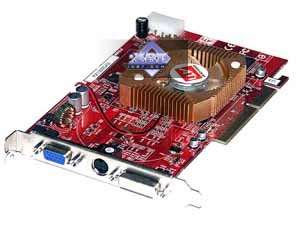
|
| Sapphire RADEON X1300 256MB AGP |
| GPU: RADEON X1300
(RV515)
Interface: AGP 2x/4x/8x
GPU frequencies: 450 MHz (nominal —
450 MHz)
Memory frequencies (physical (effective)):
245 (490) MHz (nominal — 275 (550) MHz)
Memory bus width: 128bit
Number of Shader Vertex Processors: 2
Number of Shader Pixel Processors: 4
Number of texture processors: 4
Number of ROPs: 4
Dimensions: 160x100x15mm (the last figure
is the maximum thickness of a video card).
PCB color: red.
Output connectors: VGA (d-Sub), DVI (Dual-Link),
TV-Out.
VIVO: not available
TV-out: integrated into GPU.
|

|
| Sapphire RADEON X1600 PRO 256MB AGP
|
| GPU: RADEON X1600
PRO (RV530)
Interface: AGP 2x/4x/8x
GPU frequencies: 500 MHz (nominal —
500 MHz)
Memory frequencies (physical (effective)):
405 (810) MHz (nominal — 400 (800) MHz)
Memory bus width: 128bit
Number of Shader Vertex Processors: 5
Number of Shader Pixel Processors: 12
Number of texture processors: 4
Number of ROPs: 4
Dimensions: 160x100x15mm (the last figure
is the maximum thickness of a video card).
PCB color: red.
Output connectors: VGA (d-Sub), DVI (Dual-Link),
TV-Out.
VIVO: not available
TV-out: integrated into GPU.
|

|
| Leadtek WinFast A7800 GS TDH (GeForce
7800 GS) 256MB AGP |
| GPU: GeForce 7800
(G70) + HSI (PCI-E-to-AGP Bridge)
Interface: AGP 2x/4x/8x
GPU frequencies: 375/375/415 MHz (nominal
— 375/375/415 MHz)
Memory frequencies (physical (effective)):
600 (1200) MHz (nominal — 600 (1200) MHz)
Memory bus width: 256bit
Number of Shader Vertex Processors: 6
Number of Shader Pixel Processors: 16
Number of texture processors: 16
Number of ROPs: 8
Dimensions: 205x100x15mm (the last figure
is the maximum thickness of a video card).
PCB color: green.
Output connectors: VGA (d-Sub), DVI (Dual-Link),
TV-Out.
VIVO: not available
TV-out: integrated into GPU.
|

|
| GeCube RADEON X1300 256MB AGP |
| The video card has 256 MB of DDR2 SDRAM allocated
in eight chips on the front and back sides of the PCB.
Micron memory chips (DDR2). 4.0ns memory access time, which
corresponds to 250 (500) MHz.
|
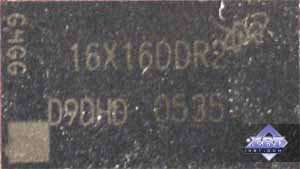
|
| Sapphire RADEON X1300 256MB AGP |
| The video card has 256 MB of GDDR3 SDRAM
allocated in eight chips on the front and back sides of the PCB.
Infineon memory chips (GDDR3). 2.8ns memory access time, which
corresponds to 350 (700) MHz.
|
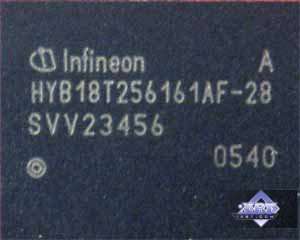
|
| Sapphire RADEON X1600 PRO 256MB AGP
|
| The video card has 256 MB of GDDR3 SDRAM
allocated in eight chips on the front and back sides of the PCB.
Infineon memory chips (GDDR3). 2.5 ns memory access time,
which corresponds to 400 (800) MHz.
|
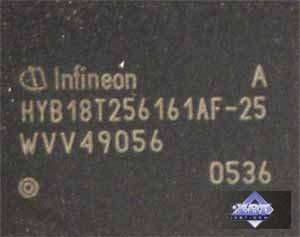
|
| Leadtek WinFast A7800 GS TDH (GeForce
7800 GS) 256MB AGP |
| The video card has 256 MB of GDDR3 SDRAM
allocated in eight chips on the front and back sides of the PCB.
Samsung (GDDR3) memory chips. 1.4ns memory access time, which
corresponds to 700 (1400) MHz.
|

|
| Comparison with the reference design,
front view |
| GeCube RADEON X1300 256MB AGP |
Reference card ATI RADEON X1300 PRO |

|
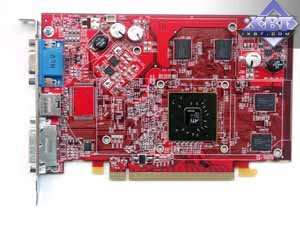
|

|
| Sapphire RADEON X1300 256MB AGP |

|
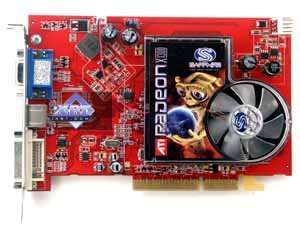
|
| Sapphire RADEON X1600 PRO 256MB AGP |
Reference card ATI RADEON X1600 XT |
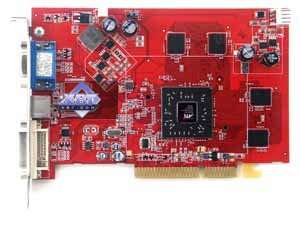
|
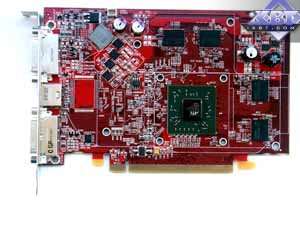
|

| |
| Leadtek WinFast A7800 GS TDH (GeForce 7800 GS)
256MB AGP |
Reference card NVIDIA GeForce 7800 GT |
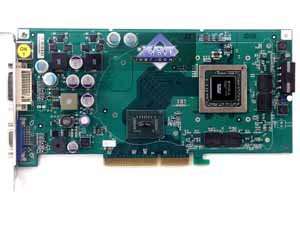
|
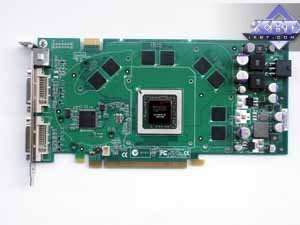
|

|
| Comparison with the reference design,
back view |
| GeCube RADEON X1300 256MB AGP |
Reference card ATI RADEON X1300 PRO |
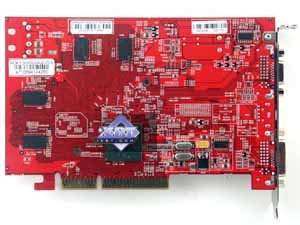
|

|
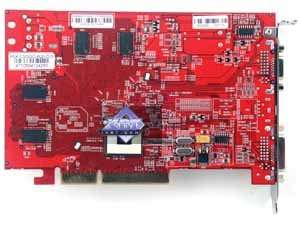
|
| Sapphire RADEON X1300 256MB AGP |
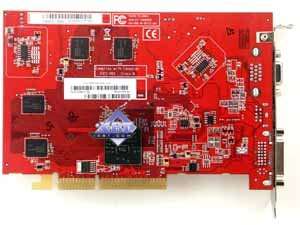
|
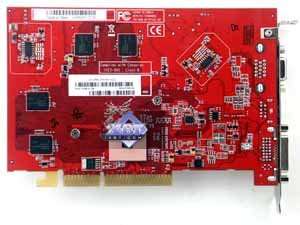
|
| Sapphire RADEON X1600 PRO 256MB AGP |
Reference card ATI RADEON X1600 XT |

|
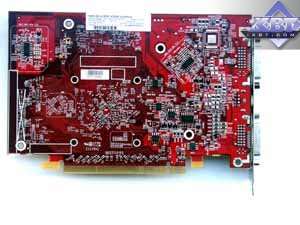
|

|
|
| Leadtek WinFast A7800 GS TDH (GeForce 7800 GS)
256MB AGP |
Reference card NVIDIA GeForce 7800 GT |

|
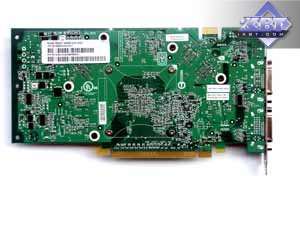
|

|
I guess there is no point in telling you that all designs differ from their PCI-E counterparts. All the four cards are equipped with the proper bridges. The X1300/X1600-based products have the bridges at the back of the PCB, the 7800 GS - on the front side. The HSI bridge gets very hot, so it needs additional cooling. So it had better be placed on the same side as the main cooler to be under the same "roof" with a GPU.
Sapphire products are similar to corresponding reference PCI-E cards. They have borrowed much from that design. And the GeCube product has a unique design, as it uses non-standard DRR2 memory. Nevertheless, all the three boards support VIVO, but only potentially: RAGE Theater chips are nowhere to be seen. It's not clear why manufacturers stinted this feature. Especially in case of the X1600 PRO.
And the 7800 GS does not support VIVO even potentially: there is just no seat for this codec.
The cards have TV-Out with a unique jack. You will need a special bundled adapter to output video to a TV-set via S-Video or RCA You can read about TV-Out in detail here.
All the three cards are equipped with VGA (d-Sub) and DVI. Analog monitors with d-Sub (VGA) interface are connected to DVI with special DVI-to-d-Sub adapters. Maximum resolutions and frequencies:
- 240 Hz Max Refresh Rate
- 2048 x 1536 x 32bit x85Hz Max - analog interface
- 2560 x 1600 / 1600 x 1200 @ 60Hz Max - digital interface
Many previously reviewed G70 (GTX) 256MB cards allowed to change all the three core frequencies at 27 MHz steps, frequency of the geometry unit was higher by 40 MHz. I already described it in detail before. This 40 MHz difference remains in the 7800 GS as well.
And the last thing: all the cards are equipped with external power connectors. What have we come to! Now even Low-End AGP products require external power supply. I just cannot comprehend it: isn't AGP bus sufficient to power the X1300? It's a 0.09-micron chip, not very complex at that!
RADEON 9600 XT (0.13 micron) had 4 pipelines, a 500 MHz chip, and didn't require much. That's strange.
| GeCube RADEON X1300 256MB AGP |
|
A very simple design. There is even nothing to describe. A
standard rectangular heatsink with a fan in the center.
We haven't registered any noise. But such coolers are notorious
for getting noisy after some time. That will not happen for
sure, it's just a possibility. The Õ1300 does not get so hot,
so this device copes well with its task.
|

|

|
| Sapphire RADEON X1300 256MB AGP |
|
This device resembles much the reference closed cooler for
X700 cards, which drives air through the heatsink. Memory chips
on the front side of the PCB are cooled, unlike the ones on
the back side - that's a drawback of this system.
The cooler is very quiet.
|

|

|
| Sapphire RADEON X1600 PRO 256MB AGP
|
|
The cooling system is similar to the previous one in its operation,
it's just a tad larger. In the same way, memory chips on the
front side are cooled by this cooler, while the back side chips
are not.
It's not very noisy.
|
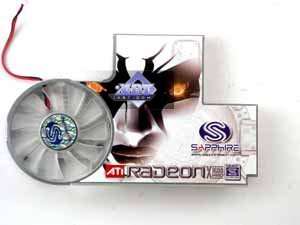
|

|
| Leadtek WinFast A7800 GS TDH (GeForce
7800 GS) 256MB AGP |
|
This cooler is almost a copy of the reference device for all
GeForce 6800 cards. A rounded narrow long heatsink of the closed
type with a turbine at one of its ends that sucks the air in
It runs at low speed, so there is almost no noise. This system
is attached to a large plate at the back of the PCB, which also
acts as a heatsink for memory chips on this side of the PCB.
|
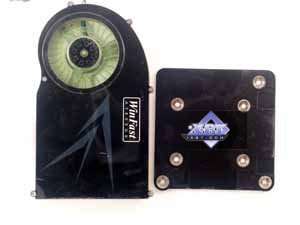
|
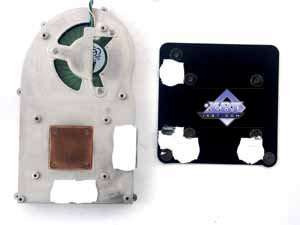
|
Bundle
| GeCube RADEON X1300 256MB AGP |
| User manual, CD with drivers, TV extension cord.
THAT'S ALL! That's practically OEM rather than a scarce bundle.
|

|
| Sapphire RADEON X1300 256MB AGP; Sapphire
RADEON X1600 PRO 256MB AGP |
| User's Manual, CD with drivers, PowerDVD, DVD
with several games (but you can choose only two of them.) You
will also find the following items in the box: DVI-to-d-Sub and
HDTV adapters, external power cables. |
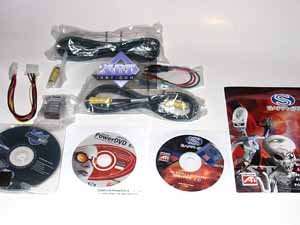
|
| Leadtek WinFast A7800 GS TDH (GeForce
7800 GS) 256MB AGP |
| User's Manual, CD with drivers, bonus CD with
PowerDVD and other interesting programs, several discs with games
Prince of Persia, SCCT, DVI-to-d-Sub and S-Video-to-RCA adapters,
external power cable. |

|
Packages.
| GeCube RADEON X1300 256MB AGP |
|
Traditional GeCube design with Ruby on the glossy jacket with
a cardboard box inside. All components are arranged into sections
inside, the card shouldn't dangle.
|
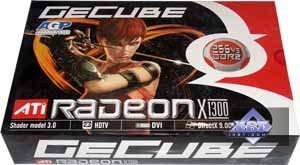
|
| Sapphire RADEON X1300 256MB AGP |
|
No less traditional Sapphire design with its sad extraterrestrial
(probably a marketing specialist - it must be hard to sell Sapphire
products on Mars). Again a glossy jacket with a cardboard box
inside.
All components are arranged into plastic sections. The card
is firmly fixed. By the way, there is a window at the back of
the box to show off the card.
|

|
| Sapphire RADEON X1600 PRO 256MB AGP
|
|
It's a similar box with a slightly different design - the
extraterrestrial becomes evil. I wonder, Sapphire employees
are all full of life and joy, like Dan Forster, but their box
designs are gloomy. Is their designer always depressed? Perhaps
the company should hire a new one? Or shock him/her out of this
depression.... Enough of such uglies, for crying out loud! Why
do all vendor representatives have an impression that the company
invented a devil and intends to sell sort of Freddy Krueger?
What concerns the inner arrangement of the box - for some reason
the company abandoned convenient and reliable plastic sections
for cardboard bays, where all bundled components just dangle.
It's disappointing to see a worse retail.
|

|
| Leadtek WinFast A7800 GS TDH (GeForce
7800 GS) 256MB AGP |
|
Leadtek is true to itself. The box is made of thick cardboard
of the new yellow-black design, which appeared on all packages
of 7800 cards. They shouldn't have abandoned nice fantasy heroes.
Everything is perfect inside: all components are arranged into
sections, the card itself is firmly fixed.
| 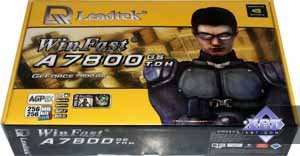
|
Installation and Drivers
Testbed configuration:
- Athlon 64 (754Socket) based computer:
- CPU: AMD Athlon 64 3700+ (L2=1024K)
- Motherboard: Albatron K8Ultra-U Pro on ULi M1689
- RAM: 2 GB DDR SDRAM 400MHz (CAS (tCL)=2.5; RAS to CAS delay (tRCD)=3; Row Precharge (tRP)=3; tRAS=6)
- HDD: Seagate Barracuda 7200.7 80GB SATA
- Operating system: Windows XP SP2 DirectX 9.0c
- Monitors: ViewSonic P810 (21") and Mitsubishi Diamond Pro 2070sb (21").
- ATI Drivers (PCI-E video cards) CATALYST 5.13; NVIDIA drivers 81.98.
VSync is disabled.
Here is the situation with overclocking:
We didn't check it, because we were pressed for time.
Test results: performance comparison
We used the following test applications:
Summary performance diagrams
In fact, we publish the last summary diagrams for all AGP cards from 3Digest. Remember that it's the last article about 3D graphics products with this interface.
Game tests that heavily load vertex shaders, mixed pixel shaders 1.1 and 2.0, active multitexturing.
FarCry, Research
Test results: FarCry Research
Game tests that heavily load vertex shaders, pixel shaders 2.0, active multitexturing.
F.E.A.R.
Test results: F.E.A.R
Splinter Cell Chaos Theory
Test results: SCCT
Call Of Duty 2 DEMO
Test results: COD2
Half-Life2: ixbt01 demo
Test results: Half-Life2, ixbt01
Game tests that heavily load pixel pipelines with texturing, active operations of the stencil buffer and shader units
DOOM III High mode
Test results: DOOM III
Chronicles of Riddick, demo 44
Test results: Chronicles of Riddick, demo 44
Synthetic tests that heavily load shader units
3DMark05: MARKS
Test results: 3DMark05 MARKS
You can find our comments in the conclusions.
Conclusions
- GeCube RADEON X1300 256MB AGP has demonstrated good results for its price, outperformed only by the GeForce 6600. I hope that price comparisons will be in favor of our product under review, or it will be of little interest. Though old models from the same camp are utterly defeated. However, core and memory frequencies speak for themselves as well as a more efficient architecture. I'd like to remind you that the product fully supports Shaders 3.0, so it can compete well with NVIDIA products. But the bundle is bad. I understand that it's a Low-End product and the manufacturer doesn't want/need to bundle it with various software. But if it's retail, be so kind not to save on trifles. The bundle does not even include necessary adapters!
Assemblage quality is up to the mark, we had no gripes with its operation. 2D quality is good up to 1600õ1200 (we speak of the analog output, of course).
- Sapphire RADEON X1300 256MB AGP - considering so great frequency differences, we can say that the card has the same results as the previous. Thus, our conclusions are the same as well. Except for the bundle: Sapphire did great here. No matter whether Low-End or Middle... That's nice. The problem is that the memory frequency in this card is too low. Why equip it with 2.8ns memory and set the frequency to 500 MHz? It's a strange way to use fast memory.
Assemblage quality is excellent, we had no gripes with its operation either. 2D quality is good up to 1600õ1200 85Hz (we speak of the analog output, of course).
- Sapphire RADEON X1600 PRO 256MB AGP is a more welcome product than the other ATI cards, because it grants AGP users a Middle-End accelerator for $130, which fully supports SM 3.0 as well as competes well with GeForce 6600/6600 GT (except for a number of tests). And even GeForce 6800LE is outperformed in some tests.
What concerns the quality, there are no differences from the previous product. Even PCBs are similar as well as their elements.
- Leadtek WinFast A7800 GS TDH (GeForce 7800 GS) 256MB AGP - many users have been impatiently waiting for this product. Though they had expected much more from it (judging from forums), the 7800 title means something. That is this card is at least on the level of the 7800 GT. But as I have already mentioned, they are based on G70 rejects, so the number of pipelines and frequencies are reduced. So we got an architectural level of the 6800 Ultra, and something in between the 6800 GT and the 6800 U in frequency terms. Though this card is equipped with very fast memory. Thus it's not limited to the 1200 MHz, as 1.4ns memory can operate at 1400 MHz.
But as the tests revealed, this product is not a transient model between the 6800 GT and Ultra. It often demonstrates better results than the 6800 Ultra! Thus it can be called nearly the most powerful AGP accelerator from NVIDIA for today! Yep, it's not absolutely the best, as the X850 XT PE is often faster (and cheaper, according to the mid March prices). But the X850 XT AGP is already hard to be found. So the 7800 GS may become the truly fastest card that is available for today (in the AGP segment). Of course, this card should cost no more than $350, but its prices are currently raised higher.
Quality. I have always liked Leadtek, because there is even no need to touch upon this issue! It's quite clear that the quality is excellent, including 2D!
You can find more detailed comparisons of various video cards in our 3Digest.
Write a comment below. No registration needed!
|
|
 |
|
|
|



